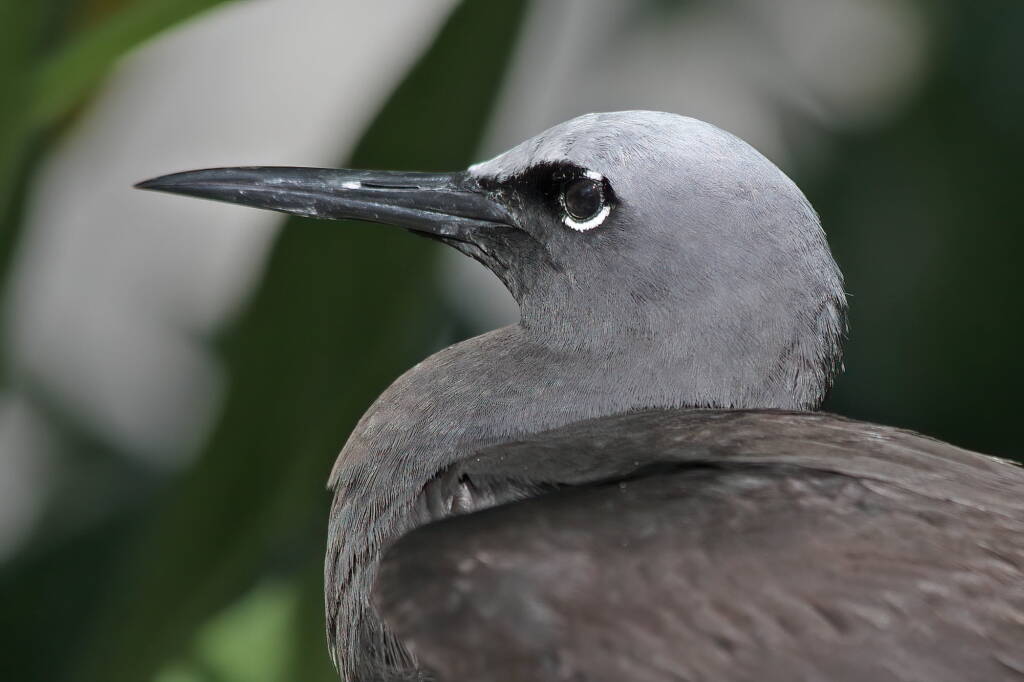The White-capped Noddy, also known as the Black Noddy (Anous minutus), is a medium-sized tern and similar to the Common Noddy. The White-capped Noddy is more blackish brown in colour with a darker underwing, a thinner bill, a greyer and shorter tail and in particular a more contrasting white cap to the Common Noddy.

When we visited Lady Elliot Island, we saw that it is home to 100,000 Noddies (although I was prepared to estimate over 1 million but more knowledgeable minds prevailed). They are in every tree and most branches. Apparently there can be 500,000 on the island during nesting season. The resort on Lady Elliot Island provides ear plugs because they are noisy little brutes… all night. The island was mined for guano in the mid 1800s which did some extensive damage to the ecology but re-vegetation has restored much of the popularity with sea birds.
Author Marc Newman

The genus name Anous comes from the ancient Greek for “stupid” or “foolish”. The species name minutus is the Latin for “small”.

Their distribution in Australia and nearby regions is particularly concentrated along the eastern side of Australia (see map distribution in Atlas of Living Australia below), and in particular on many of the islands off the east coast of Australia.
Lady Elliot Island is the southernmost coral cay of the Australian Great Barrier Reef. The island covers an area of approximately 45 hectares and is part of the Capricorn and Bunker Group of islands.
- Scientific classification
- Kingdom: Animalia
- Phylum: Chordata
- Subphylum: Vertebrata
- Informal: Gnathostomata
- Class: Aves
- Order: Charadriiformes
- Family: Laridae
- Subfamily: Sterninae
- Tribe: Anoini
- Genus: Anous
- Species: Anous minutus Boie, 1844
- Subspecies: Anous minutus minutus Boie, 1844
Footnote & References
- Photographs © Marc Newman, Flickr, https://flickr.com/photos/koolbee/albums
- Anous minutus Boie, 1844, Black Noddy, Atlas of Living Australia, https://bie.ala.org.au/species/urn:lsid:biodiversity.org.au:afd.taxon:bd14c0ba-b63e-4692-a5de-f1daef16b8ef
BirdsApostlebird Australasian Darter Australasian Figbird Australasian Gannet Australasian Grebe Australasian Pipit Australasian Robins Australasian Shoveler (Spatula rhynchotis) Australasian Wrens Australian Babblers Australian Bustard Australian Chats Australian Magpie Australian Pelican Australian Pratincole (Stiltia isabella) Australian White Ibis Bassian Thrush Black-faced Cormorant Black-faced Woodswallow Black Swan Bowerbirds Brolga Brown Songlark Channel-billed Cuckoo Cinnamon Quail-thrush Cormorants Cuckooshrikes and Allies Dotterels Lapwings Plovers Doves & Pigeons Emu Fairy Martin Finches Grey Fantail Grey Teal Honeyeaters Kingfishers Little Friarbird Little Grassbird Magpie-lark Masked Woodswallow Noisy Pitta Olive Whistler Paradise Riflebird Pardalotes Parrots Pheasant Coucal Pied Butcherbird Rainbow Bee-eater Raptors Rufous Fantail Redthroat Rufous Bristlebird Silver-crowned Friarbird Torresian Crow Waders Welcome Swallow (Hirundo neoxena) Whiskered Tern (Chlidonias hybrida) White-browed Woodswallow White Capped Noddy White-faced Heron White-necked Heron Willie Wagtail Yellow-throated Scrubwren
